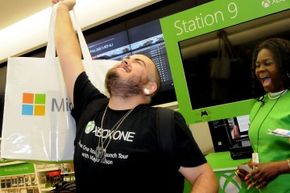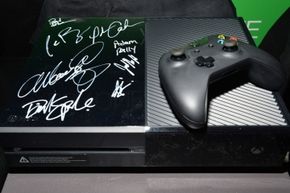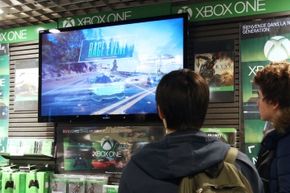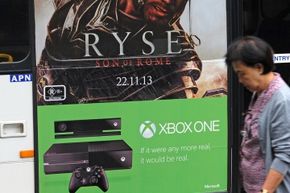There are some striking similarities between the Xbox One and the PS4, including the fact that their CPUs and GPUs are closely related and they have the same memory and storage sizes. But the hardware does have some differences that could affect performance.
PS4 has an 8-core single-chip x86 AMD Jaguar CPU that comes from the same AMD "Sea Islands" family as Xbox One's more customized CPU. It has 8GB of 5500MHz GDDR5 RAM (faster than Xbox One's DDR3 RAM, but without their extra integrated ESRAM) and a 500GB removable hard drive. Xbox One's similarly sized hard drive is not removable, but Xbox will at some undisclosed point in the future allow the addition of external storage via USB.
PS4 has an 800MHz PlayStation-customized AMD Radeon Graphics Core Next engine GPU with 18 CUs, which is six more CUs than Xbox One's GPU, running at 1.84 teraFLOPS per second at peak.
Both consoles can display 1080p high-definition at 60 frames per second (fps), although there has been press about some games running at lower (but still high-def) resolutions on Xbox One than on PS4. Still, they both have stellar, somewhat comparable graphics that are improvements over their predecessors.
Both have Ethernet and 802.11 b/g/n connectivity. PS4 also has BlueTooth. Xbox One uses Wi-Fi Direct for device-to-device wireless connection instead. Both have HDMI and optical output, but Xbox One is also capable of HDMI input, so PS4 won't be able to stream video from your cable or satellite box.
PS4's new DualShock 4 controller had some comfort improvements and now includes a touchpad, but otherwise remains similar in layout to the previous controller. You can only connect four controllers at a time to PS4, compared to Xbox One's eight.
Xbox One comes standard with the Kinect. PS4's Eye (their voice- and motion-detecting device) must be purchased separately. Kinect's new model is also reportedly a bit better than the Eye. The new Kinect has a 1080p resolution RGB camera versus the Eye's 720p, and Kinect is the only one with IR blaster, which bounces infrared light off of things to measure depth and see in the dark. PS4's Eye uses two cameras to triangulate your location. Eye no longer requires special Move controllers, although you can still use them.
Both systems utilize cloud computing to store your data and enhance games and apps, and both allow for running multiple apps and switching quickly between them. Neither have backward compatibility with old games, unfortunately, so you may have to keep your old consoles for a while if there's a title you can't live without.
Xbox One will reportedly be able to stream media from your PC or network-attached storage (NAS) drive, and some certified Digital Living Network Alliance (DLNA) devices, although only from devices that use the Microsoft Play To standard. PS4 does not include DLNA capabilities. PS4 also can't play CDs or MP3s, although it can play music via streaming apps.
Like Xbox One, PlayStation 4 also has a gaming DVR. It can record up to 15 minutes of gameplay and will allow you to share via Facebook at first, and YouTube later.
Both Xbox One and PlayStation 4 have smartphone and tablet apps that can be used to control the console or display additional information. The PlayStation Vita handheld game device can also be used with PS4 for remote control and second-screen features, and even lets you play games remotely elsewhere in the house through the Remote Play option.
Sony initially provided more support for independent game developers, so there may be more small indie games for PS4. But Microsoft says that all Xbox One consoles can act as free development units and that they will allow self-published titles, possibly with certification -- a departure from earlier policy announcements.
On Xbox One, TV streaming, multiplayer online gaming and Skype require the annual Xbox Gold membership. PlayStation 4 will allow you to run streaming apps and do video chat without any extra fees, but you have to purchase the annual PlayStation Plus subscription to participate in multiplayer online gaming.
In the U.S., PS4 was released on November 15, 2013 with a retail price of $399.99, $100 cheaper than Xbox One. That is without the optional Eye, which is $59.99 as of November 2013. That brings PS4 in at a slightly lower cost than Xbox One. But which people choose may depend largely on user preference, and what console their friends have.







